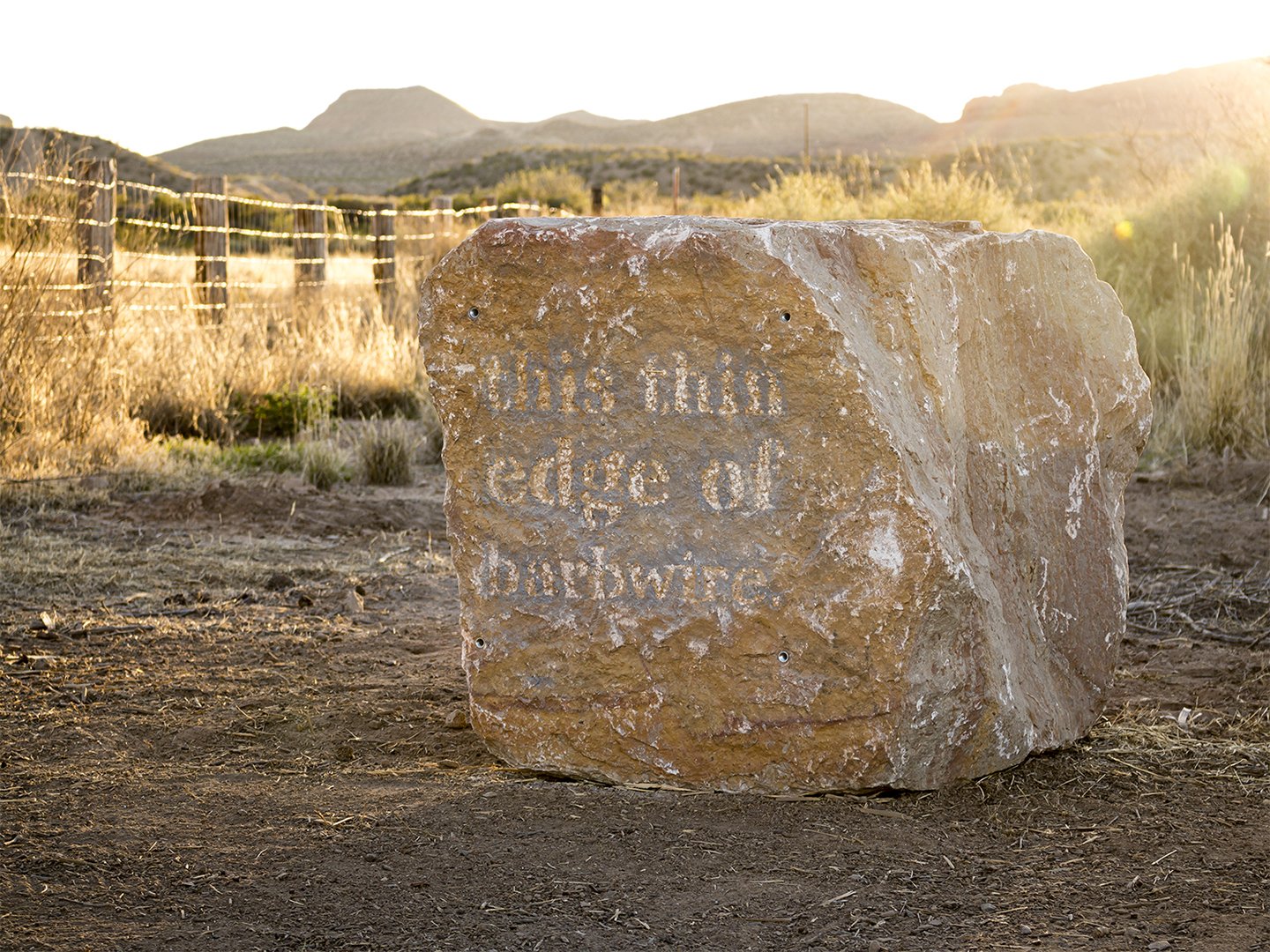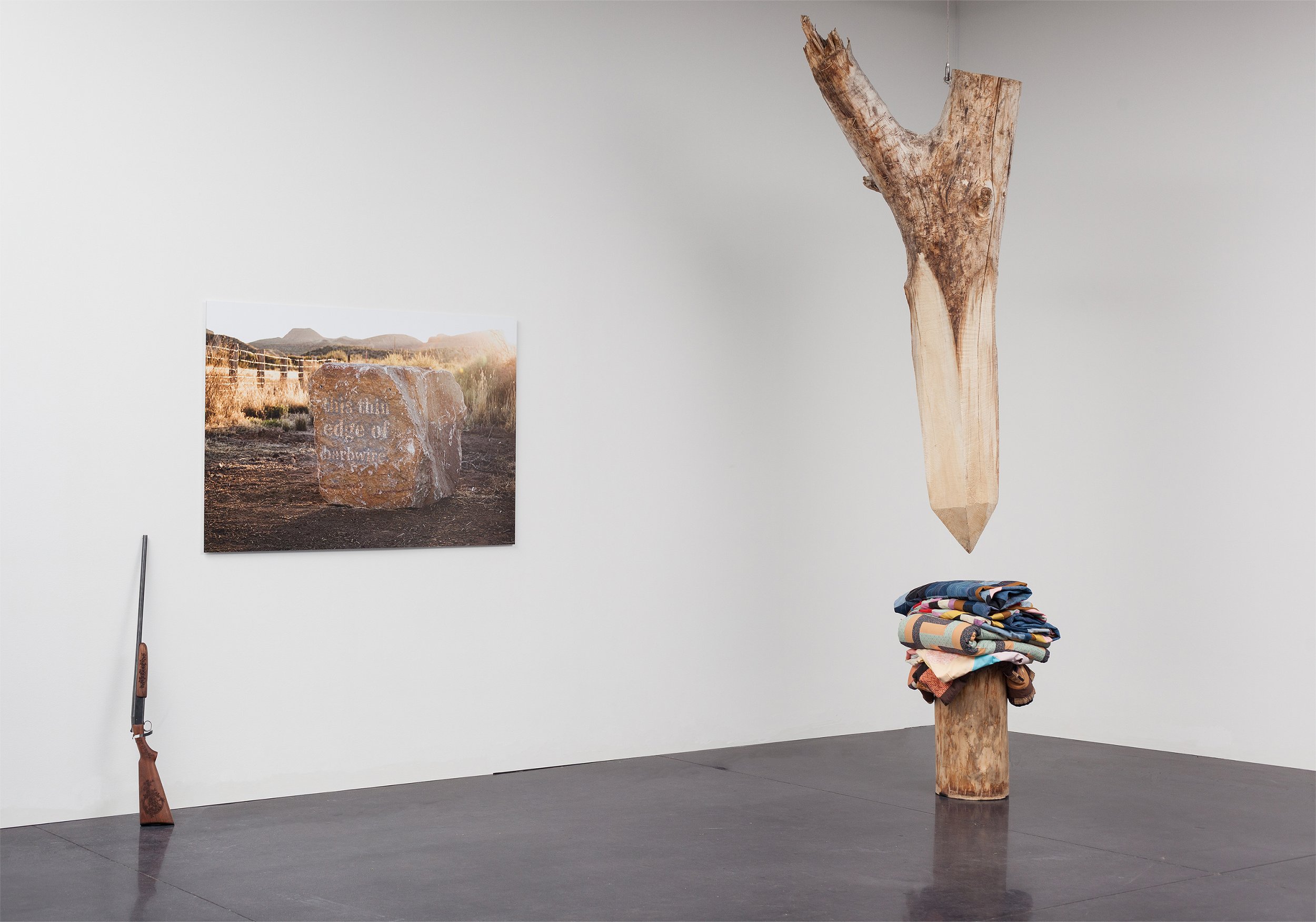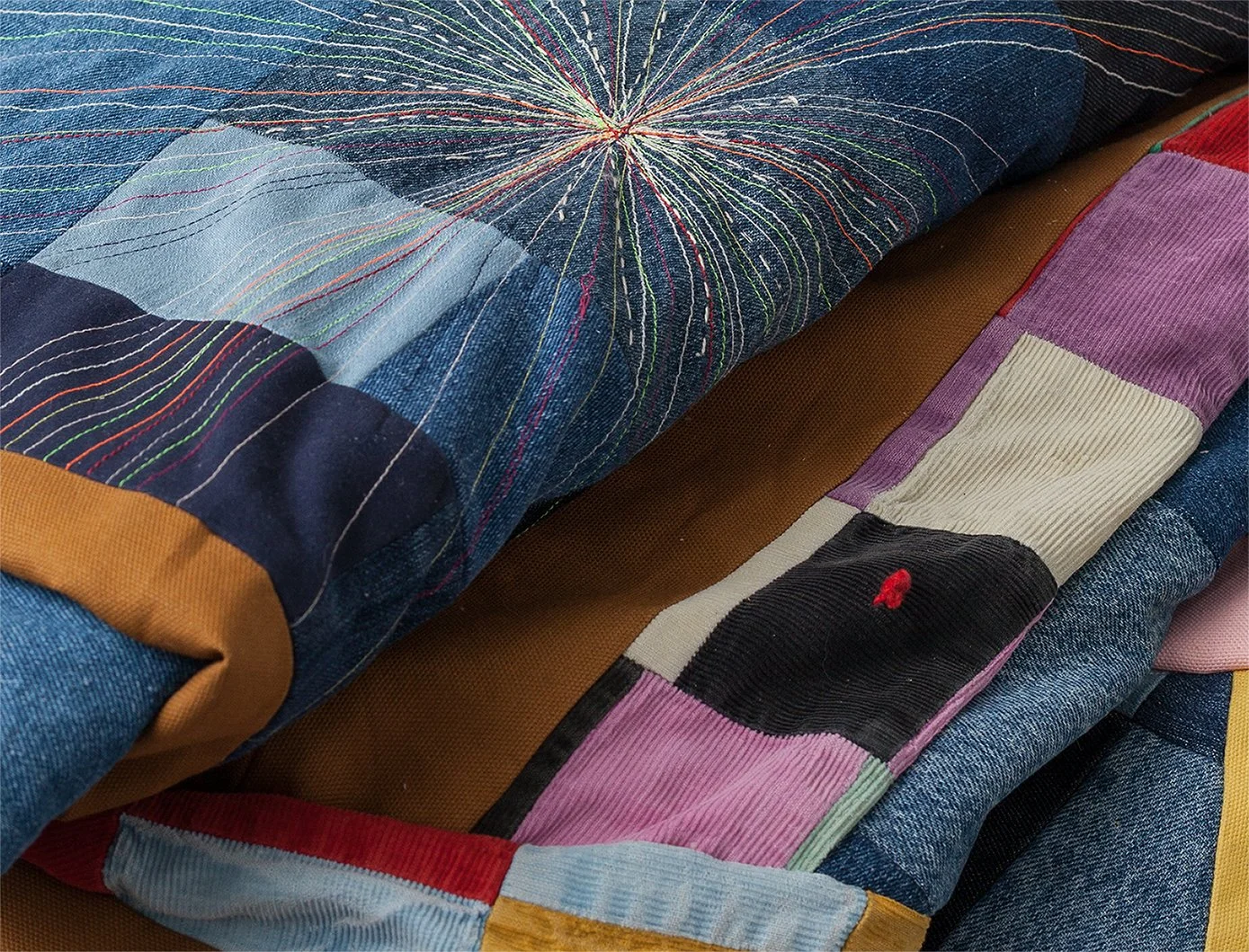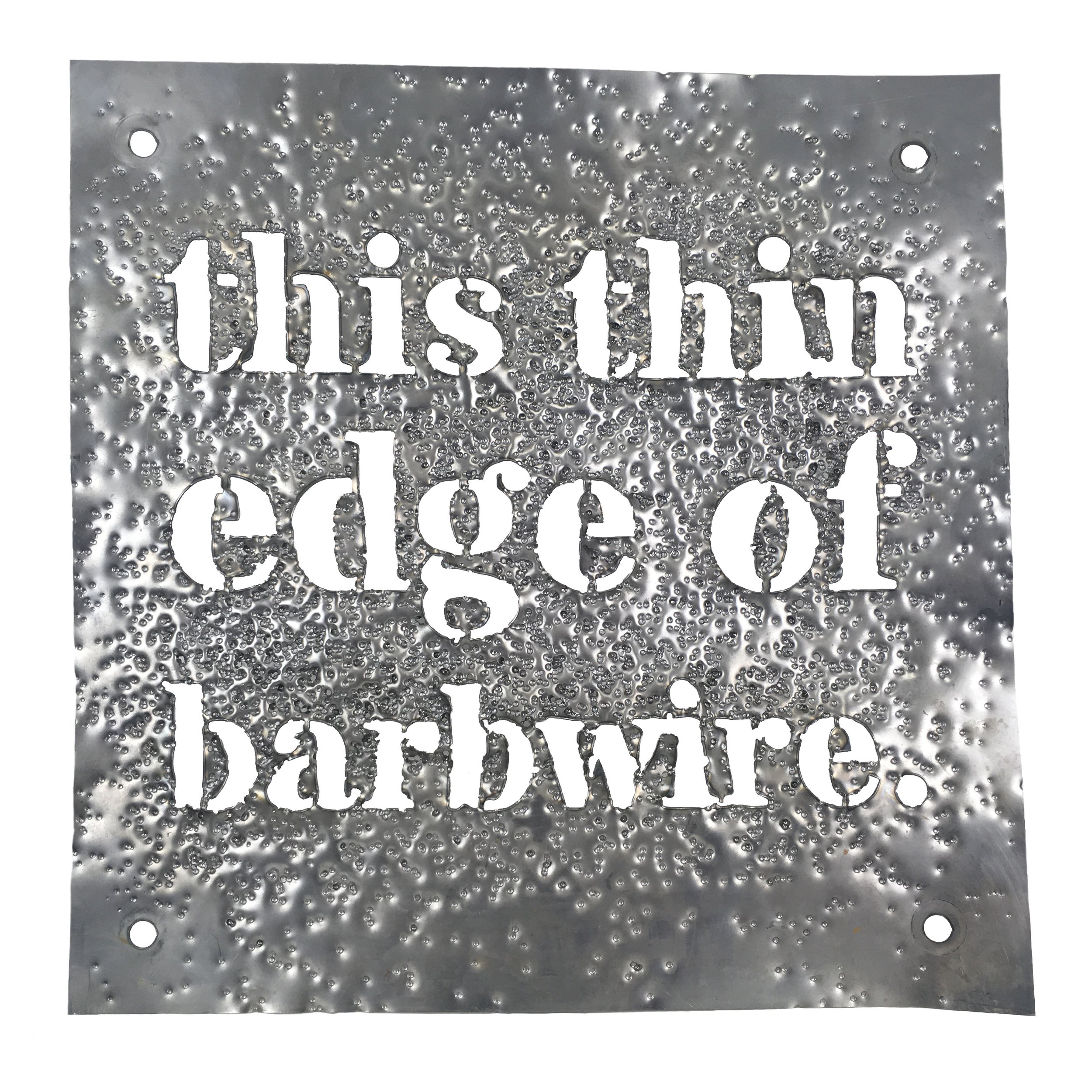“In-between spaces and border identity” Ewelina Chwiejda on Carissa Samaniego
A shotgun, a picture of a carved boulder, a hanging log, and a stack of textiles. At first glance, the objects constituting Carissa Samaniego's installation "Riding the Fence, Pulling the Trigger" may seem disconnected and enigmatic, even though their association immediately strikes viewers' attention and invites them to explore it. One deep dive into the context for the creation of this installation allows the audience to notice the subtle yet powerful connotations that every exposed object bears as well as the way they complete and converse with each other. Samaniego's project, which this installation is a part of, presents itself as a very personal investigation of mixed identity and, at the same time, becomes a universal meditation on roots, borders, and forms of belonging.
As an artist of mixed origins, raised between a small town on Minnesota’s prairie and a twelve-generation Nuevomexicano family in the borderlands of the Southwest, Carissa Samaniego explores through her artworks the in-between spaces of personal identity and cultural narrative shaped by place, history. The entirety of her artistic activity is focused on this exploration that takes multiple forms, from drawing, writing, and photographs to gallery and site-specific installations. Created in 2017, "Riding the Fence, Pulling the Trigger" appears to be one of the most thought-provoking and comprehensive manifestations of her reflection on mixed identity and cultural hybridity. It is a multidimensional project that, while being object-oriented, has a solid conceptual background. The creation of the final installation has been preceded by extensive on-site research related both to the artist’s personal and family experience, and to the place that remain inextricably linked one to another. The project consists of object-based installation and a mark-making performance documented on the video accessible on the artist's website. The result of this performance is a carved limestone boulder represented on the photograph exposed in the exhibition space with other highly-symbolic artifacts.
Objects and materials
The objects composing Carissa Samaniego's installation have double connotations. First of all, they refer to her personal history, family traditions and knowledge, mainly the crafts of her parents that she appropriates in her project. Secondly, they connect this personal, intimate dimension of the artifacts to the artist's place of origin and cultural heritage. This connexion passes through utilized materials and handling methods. Being a daughter of a New Mexican gunsmith and a Minnesota quilter, Samaniego disposes of a rich source of inspiration, which she creatively exploited in this project by playing with the original function of the appropriated objects. A 20-gauge shotgun, traditionally associated with hunting, defense or aggression has been decorated by the artist with a carved creosote branches in bloom typical of the Chihuahuan Desert landscape, an ancestral homeland. A large patchwork map, made of denim, folded in a multilayer-pile was created with the help of her mother and references places the artist was raised in. By the use of this specific textile, Samaniego, inspired by Jim Hodges's "Untitled (one day it all comes true)," evokes a broader American identity. This gesture may be interpreted as a desire to inscribe her personal experience and places meaningful to her into a more extensive cultural landscape. A traditionally feminine craft and material take a more universal or even political meaning through this artistic choice.
Similarly, Samaniego has inverted the primary masculine connotation of a gun, which she transformed in her performance into a sculpting tool to carve a fragment of Gloria Anzaldúa's poem in the limestone boulder quarried from the Robledo Mountains. The engraved text is the second section of a line saying, "This is her home, this thin edge of barbwire," a reference to the in-between space of a borderland that for Samaniego represents her homeland. The boulder itself recalls the form of a landmark pointing out the frontier between territories or a symbolic place. And the viewer of Samaniego's installation can also easily identify a similar original function in the suspended wood log that the artist gave a shape of an inverted obelisk. The top of it faces the stack of quilts exposed on another piece of wood, creating the impression that the denim map is imprisoned between those landmarks, stuck in this in-between space metaphorically reproduced by Samaniego.
In this way, initially unrelated objects become tightly bound to each other; they are complementary and co-dependent. Reading them separately proves to be impossible at the risk of missing the message encoded in their forms and materials. Brought together, they reveal new layers of the artist's identity, being itself a patchwork of different cultures and traditions.
Borderlands and the notion of in-betweenness
There is no doubt that the border represents much more than just a physical delineation between two territories. The sole fact that borders are artificially defined, very fluid, and have a 'polysemic nature' as defined by sociologist Étienne Balibar (2002), drives our attention to their psychological dimension that plays a crucial role in the construction of one's identity. The concept of the 'polysemic nature' of a border refers to the fact that the same border is perceived differently by individuals representing different social classes, origins, or maintaining diverse connections with it. Borderlands crystalize this polysemy and complexity of relationships even more than any other physical space because they are an arena of everyday negotiations of identity.
Having mixed origins and being raised in a borderland like Carissa Samaniego is a deeply constitutive experience for one's identity and feelings of belonging. When a borderland – the in-between space by definition, sometimes identified as no man's land as is the case for some territories at the frontier between Mexico and the United States – becomes one's homeland, there is a need to find a way to integrate this complex identity. There comes a very human tendency for storytelling. Researchers in psychology stress the importance of what they call border identity narratives created by the inhabitants of international borderlands in order to make sense of their self's experience of living in these specific in-between spaces (Español, De la Mata, Cornejo 2021: 2). "Riding the Fence, Pulling the Trigger" can be seen as an artistic manifestation of this process. Carissa Samaniego translates her personal experience of the border into a visual representation in which any object or creative gesture constituting the project reconstructs a part of her hybrid identity.
On the one hand, it is very personal as her individual story and experience are essential to this artwork. Without any indications, the audience cannot fully embrace the complex meaning of the exposed objects. It shows that the individual experience is central to this question, that borders and borderlands are constantly approached and understood individually when it comes to their non-physical dimension. On the other hand, besides the personal references, there is also a more universal part of the project, which provokes the viewer to a broader reflection on the complexity of the identity structures. At the very general level of interpretation, the fabrics and the unusual association of objects in the exhibition space let the viewer look for their own references and may lead to discoveries related to their own identity. The notion of border and in-betweenness is evoked by Samaniego in many ways, and there is no need to share the same experience of living in a borderland to relate to her vision of intersectional identity. As the above-mentioned researchers claim, the construction of border identity narratives, on a psychological plane, concerns everyone because human beings use this type of dialogical narrative to structure their experiences in the process of the construction of the self (Español, de la Mata, Cornejo 2021).
Identity narrated through art
Indeed, everything is dialogical in the identity narrative rooted in two cultures, traditions, and places. The borderland is a spot of convergence that defines the modes of belonging. A person raised or living in a borderland adopts the position of being-in-the-world on the border as defined by anthropologist Michel Agier in his book "Borderlands" (2016: 71). With this publication, Agier investigates the new cosmopolitan condition and identifies several figures of inhabitants of a contemporary world defined by visible and invisible borders. Even though the scholar refers mostly to migrants and refugees, there are some similarities between them and Samaniego’s experience of being raised in a mixed family and internalizing the border in its diverse dimensions. Everything in her project, from its very title to the used objects and the mark-making part, points towards this in-between condition and its inherent duality: the desire to connect sometimes very different things and traditions, not to neglect or forget anything and at the same time, an urgency to decide where she belongs, to have her place, a point of reference.
This mark-making process repeated several times while creating the installation – gunshots, carving in the gun and wood log, quilting the map is probably the best illustration of this need of marking her own territory, leaving traces, and symbolically stabilizing the fluid identity, at least at some point. The artist writes about the creation of her artwork in these words: "It has been a process of working through understanding mixed identity and hybridization to arrive at the place of feeling complete in an in-between space" (Samaniego, 2017: 5). This reminds us of the fact that general concepts such as border, identity, or cultural hybridization are only intellectual concepts; unless they are related to the actual places and people who give them essence and form. Consequently, they can only be successfully approached and understood through an individual lens – personal experiences, stories, and objects.
In "Riding the Fence, Pulling the Trigger" Samaniego reconstructs her identity without falling into identity trap (Agier 2016: 134), that would attribute to her one fixed and quite stable identity, for example, if she insisted on belonging more to one culture or nation than other, and inlock her in it. By escaping reductionist identifications, by staying close to her personal experience as much as possible, and by making this artwork multidimensional, she manages to expose the complexity of a mixed identity with all its fragility and strength.
References:
Agier, Michel (2016), Borderlands: Towards an Anthropology of the Cosmopolitan Condition, United Kingdom: Polity Press.
Balibar, Étienne (2002), What is a border? In: Politics and the Other Scene. London; New York: Verso, 75–86.
Español, Alicia, De la Mata, Manuel Luis, Cornejo, Marcela (2021), “Border identities: Theoretical approach to the study of self from bordering processes”, Theory & Psychology 31(5), 675-691. DOI: 10.1177/09593543211020129
Samaniego, Carissa (2017), “Riding the Fence, Pulling the Trigger”, Master thesis, University of Colorado Boulder.
Carissa Samaniego is an interdisciplinary visual artist based in Colorado (USA). Her work explores the intersection of place and identity though family traditions, generational knowledge, natural history, and cultural ephemera based on her own experience growing up between a reserved rural community on the Minnesota prairie and a close-knit Nuevomexicano family in the borderlands of the Southwest. She exhibits widely with recent project sites including Galerie Klatovy-Klenova (Czech Republic), Kidwelly Industrial Museum (Wales), Franconia Sculpture Park (MN), Union Hall (CO), and the Border Art Residency (TX). She holds an MFA in Sculpture and Post-Studio Practice from the University of Colorado Boulder.






